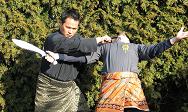|
Bersilat means "to
do fighting" . this Malaysian martial art is similar to Pentjak Silat, an
Indonesian martial art, which it is thought to have derived from. It is a
self defense system dating from the fifteenth century. There are several
schools of Bersilat, each with two branches, one for public display and one
for combat. |
 |
|
Silat pulat is a
dance-like art, usually performed at weddings and other festivities. Silat
buah is for combat. Some schools emphasize unarmed combat while others focus
on weapons usa. Minangkabau is the name of the woman who introduced the art,
which imitates the movement of animals like Chinese styles do. Bersilat
emphasizes leg techniques, but punches, throws and holds are so important.
Students are forbidden to divulge secrets and training is often handed down
from family member to family member. The art has both a sport side and a
spiritual side. The most important styles of Bersilat are Chekak, Kelantan,
Lintan, Medan, Peninjuan, and Terelak.
LINTAN Malaysian Bersilat style; two opponents
fight without weapons.
MEDAN Style of Bersilat; weapons are used in
mass fighting.
SILAT BUAH Secondary form of Malaysian
Bersilat, used in actual combat. Generally practiced in semi-seclusion, its
moves are passed from master to disciple under a vow of secrecy, reminiscent
of Chinese kung-fu. Various forms of Silat Buah can be found throughout the
narrow peninsula of Malaysia, but the most popular forms are fist and finger
attacking, grappling and gripping, and a spectacular style with high leaps
and flying kicks.
TERELAK style of Bersilat; breathing is
stressed and great strength is required.
This Malaysian martial art focuses on seven basic groups of techniques that
are practiced faithfully and must be mastered by each practitioner. they
are:
1. Salutation
2. Weapon Forms
3. Avoiding Attack
4. Side Stepping (Footwork)
5. Kicking or falling Techniques
6. Stabbing Techniques
7. Art of the Warrior Techniques |













